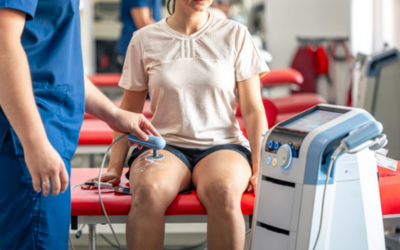Dr. Mohan Menon, a leading medical oncologist in Mumbai, emphasizes the importance of early detection and patient education in post-treatment care.
“Lymphedema isn’t just about swelling,” says Dr. Menon. “It reflects deeper disruptions in the lymphatic system, often requiring long-term vigilance and dedicated care.”
His clinical experience has shown that timely intervention and patient awareness can make a significant difference in managing lymphedema after cancer.
What Is Lymphedema?
Lymphedema is a condition characterized by the accumulation of lymphatic fluid in the tissues, leading to swelling—most commonly in the arms or legs. The lymphatic system, a crucial part of your immune and circulatory systems, helps drain fluid, remove waste, and fight infections.
When this system is damaged—often during cancer treatments like surgery or radiation—cancer-related lymphedema can develop. The condition can be classified as:
- Primary Lymphedema: Rare and usually inherited.
- Secondary Lymphedema: More common and typically arises post cancer treatment, due to lymph node removal or damage.
Though often associated with breast cancer survivors, lymphedema in cancer survivors is not exclusive to one type of cancer. It can affect those treated for head and neck cancers, gynecological cancers, prostate cancer, and melanoma, among others.
What leads to this condition after cancer treatment? Let’s find out.
Causes of Lymphedema After Cancer
The causes of lymphedema after cancer largely revolve around how cancer treatments interfere with the lymphatic system. They include:
- Lymph Node Dissection
Surgical removal of lymph nodes, often necessary for staging or treating cancer, disrupts lymphatic flow.
- Radiation Therapy
Radiation can scar or damage lymphatic vessels, reducing their capacity to drain lymph fluid efficiently.
- Tumor Growth or Recurrence
In some cases, tumors press against lymph nodes or vessels, blocking fluid flow and leading to swelling.
- Infections
Post-treatment infections in areas with poor lymphatic drainage can trigger or worsen lymphedema.
While not every cancer patient will develop it, the risk of lymphedema in cancer survivors increases with the extent of treatment, especially when surgery and radiation are combined.
Book an evaluation as soon as symptoms arise to minimize long-term complications and maintain limb function.
Early Signs and Symptoms You Shouldn’t Ignore
Lymphedema symptoms after cancer often appear gradually. They may include:
- Swelling in part or all of the arm, leg, or affected area
- A feeling of heaviness or tightness
- Restricted range of motion
- Aching or discomfort
- Hardening or thickening of the skin (fibrosis)
- Recurring infections in the swollen area
The symptoms might fluctuate at first, making them easy to dismiss. However, any new or persistent swelling after cancer treatment should be evaluated promptly. Early intervention significantly improves lymphedema care in cancer patients.
Diagnosis and When to Seek Help
Diagnosis usually begins with a detailed clinical evaluation, followed by imaging tests such as:
- Lymphoscintigraphy: Assesses lymphatic flow using radioactive tracers.
- Doppler Ultrasound: Rules out blood clots.
- MRI or CT scans: Helps visualize deeper tissue involvement or tumor recurrence.
If you notice any signs of lymphedema, consult your oncologist or a certified lymphedema therapist. According to Dr. Mohan Menon,
“Prompt diagnosis ensures timely management and reduces the risk of irreversible tissue damage. It’s always better to be proactive than reactive.”
Lymphedema Management & Treatment Options
There’s no cure, but comprehensive care can transform your quality of life.
Managing lymphedema after cancer involves a multi-pronged approach aimed at reducing swelling, preventing complications, and improving mobility. Key strategies include:

Complete Decongestive Therapy (CDT)
A gold standard in treatment, CDT combines manual lymph drainage (MLD), compression therapy, skin care, and exercise.

Compression Garments
Custom-fitted sleeves or stockings help maintain pressure and prevent fluid accumulation.

Manual Lymph Drainage
A specialized massage technique that stimulates lymphatic flow and drainage.

Exercise and Physical Therapy
Gentle, low-impact exercises can help restore mobility and stimulate fluid movement.

Laser Therapy and Pneumatic Compression Devices
Advanced tools that can complement traditional treatments.
Daily Life with Lymphedema: Tips for Long-Term Management
Long-term lymphedema care in cancer patients requires a lifestyle shift. Here are practical tips for daily life:
Skin care is critical
Always keep the affected area clean and moisturized to prevent infections. Avoid cuts, burns, and insect bites.
Watch for early signs
Monitor swelling or discomfort, especially after overexertion or travel.
Elevate and move
Regularly elevate the affected limb and stay active to promote lymphatic circulation.
Wear compression as prescribed
Adhere to your compression schedule, especially during travel or physical activity.
Stay hydrated and maintain a healthy weight
Obesity can worsen symptoms, while good hydration supports lymphatic function.
Adapting to life with lymphedema takes time, but it’s possible to maintain an active, fulfilling lifestyle with the right strategies.
Frequently Asked Questions
Is lymphedema permanent after cancer?
In many cases, yes. While lymphedema can be managed effectively, it is usually a chronic condition. Ongoing care is essential.
How soon after treatment can lymphedema appear?
Lymphedema can occur weeks, months, or even years after cancer treatment. Continuous monitoring is vital.
Can lymphedema be prevented?
While it can’t always be prevented, early risk identification and preventive care (e.g., limb protection, gentle exercises) can reduce its likelihood.
Is it dangerous if left untreated?
Yes. Untreated lymphedema can lead to infections, skin hardening, reduced mobility, and emotional distress.
What kind of doctor should I consult for lymphedema?
A multidisciplinary team approach works best—start with your oncologist and consider referral to a certified lymphedema therapist or physical rehabilitation specialist.





